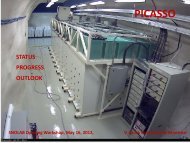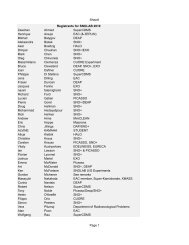Levels of heavy metals in candy packages and candies ... - snolab
Levels of heavy metals in candy packages and candies ... - snolab
Levels of heavy metals in candy packages and candies ... - snolab
Create successful ePaper yourself
Turn your PDF publications into a flip-book with our unique Google optimized e-Paper software.
414 K.-C. Kim et al. / Food Research International 41 (2008) 411–418<br />
to dissolve the Cr(VI) <strong>and</strong> stabilize it aga<strong>in</strong>st reduction to<br />
trivalent chromium. After cool<strong>in</strong>g to ambient temperature<br />
the solution was filtrated through a 0.45 lm membrane filter.<br />
The dissolved Cr(VI) <strong>of</strong> the digestion solution was analyzed<br />
colorimetrically by reaction with diphenylcarbazide<br />
<strong>in</strong> acid solution. Addition <strong>of</strong> an excess <strong>of</strong> diphenylcarbazide<br />
yielded a red-violet product, <strong>and</strong> its absorbance was<br />
measured photometrically at 540 nm by UV–Vis spectrophotometer<br />
(Sc<strong>in</strong>co, S-3100, South Korea). To compensate<br />
for possible slight losses <strong>of</strong> Cr dur<strong>in</strong>g digestion or other<br />
operations <strong>of</strong> the analysis, Cr(VI) st<strong>and</strong>ard solutions were<br />
treated by us<strong>in</strong>g the same procedure as that used for the<br />
sample, <strong>and</strong> reagent water was used as the sample blank.<br />
The calibration ranges for Cr(VI) were typically between<br />
200 <strong>and</strong> 1000 lg l<br />
1 . To verify the absence <strong>of</strong> <strong>in</strong>terference<br />
dur<strong>in</strong>g solvent extraction, alkal<strong>in</strong>e digestion <strong>and</strong> color<br />
development, recovery tests were accomplished by analyz<strong>in</strong>g<br />
the samples that has been spiked with Cr(VI).<br />
2.4. Migration test<br />
Migration test was carried out to <strong>in</strong>vestigate the migration<br />
possibility <strong>of</strong> <strong>heavy</strong> <strong>metals</strong> from <strong>c<strong>and</strong>y</strong> <strong>packages</strong> to<br />
c<strong>and</strong>ies. As a sample for the migration test, pieces <strong>of</strong> polyethylene<br />
film (yellow <strong>c<strong>and</strong>y</strong> <strong>packages</strong>, total surface area:<br />
50 cm 2 ) were immersed <strong>in</strong> 200 ml <strong>of</strong> food simulant solutions<br />
under acidic (pH 4.0), neutral (pH 7.0), <strong>and</strong> basic<br />
(pH 10.0) conditions, <strong>and</strong> all the samples used <strong>in</strong> the migration<br />
test conta<strong>in</strong>ed 6394 mg kg 1 <strong>of</strong> Pb <strong>and</strong> 1428 mg kg 1<br />
<strong>of</strong> Cr. This was a 30-day test with <strong>in</strong>terim measurements<br />
be<strong>in</strong>g taken at days 1, 2, 3, 4, 5, 7, 10, 15, 20, 25 <strong>and</strong> 30<br />
at room temperature. For each measurement, 20 ml was<br />
taken <strong>and</strong> concentrated to 1–2 ml, <strong>and</strong> then diluted to<br />
10 ml with 0.5 mol l<br />
1 HNO 3 . All the migration measurements<br />
were made <strong>in</strong> duplicate.<br />
3. Results <strong>and</strong> discussion<br />
3.1. Analytical quality assessment<br />
3.1.1. L<strong>in</strong>earity <strong>of</strong> calibration curves<br />
Under the experimental conditions described <strong>in</strong> the<br />
above materials <strong>and</strong> methods section, l<strong>in</strong>ear calibration<br />
Table 2<br />
Recovery studies for the determ<strong>in</strong>ation <strong>of</strong> the <strong>heavy</strong> <strong>metals</strong><br />
Analytical<br />
<strong>in</strong>strument<br />
Heavy<br />
<strong>metals</strong><br />
Spiked<br />
concentration<br />
(lgl<br />
1 )<br />
Mean<br />
recovery ± SD<br />
(%) a<br />
ICP-OES Pb 200 98.5 ± 2.1<br />
Cd 200 102.4 ± 1.9<br />
Cr 200 100.2 ± 1.4<br />
Cu 200 98.5 ± 2.4<br />
Mn 200 102.3 ± 2.2<br />
Co 200 99.5 ± 1.7<br />
Zn 200 103.2 ± 2.4<br />
UV–Vis- spectrophotometer Cr(VI) 400 100.9 ± 1.5<br />
a SD is the st<strong>and</strong>ard deviation <strong>of</strong> the mean recovery.<br />
Table 3<br />
<strong>Levels</strong> <strong>of</strong> <strong>heavy</strong> <strong>metals</strong> <strong>in</strong> <strong>c<strong>and</strong>y</strong> <strong>packages</strong><br />
Manufactur<strong>in</strong>g country (sample no.) Concentration <strong>of</strong> <strong>heavy</strong> <strong>metals</strong> (mg kg 1 )<br />
Cu Cd Pb Mn Cr Co Zn<br />
South Korea (31) ND–115.3 (8.18) a ND b ND–9.9 (1.05) ND–1.1 (0.1) ND–44.2 (2.38) ND–3.0 (0.15) ND–114.8 (6.61)<br />
Ch<strong>in</strong>a (39) ND–354.6 (20.38) ND–7.74 (0.5) ND–6394.1 (356.9) ND–5.5 (0.39) ND–1429.3 (81.52) ND–1.2 (0.18) ND–2579.5 (187.7)<br />
Mexico (3) 10.9–66.1 (30.34) ND 2.0–45.0 (17.65) ND ND ND 2.4–9.4 (5.29)<br />
Malaysia (3) 0.8–8.55 (3.43) ND–0.20 (0.06) 0.5–158.4 (53.3) ND 0.3–29.3 (10.03) ND–0.3 (0.15) ND–230.0 (78)<br />
Indonesia (3) 3.7–529.8 (181.2) ND 0.3–6.5 (2.53) ND 0.2–1.5 (0.76) 0.2–0.3 (0.24) 0.7–81.6 (30.6)<br />
USA (2) 16.4, 87.2 ND ND ND ND ND 3.2, 74.3<br />
Colombia (2) 3.3, 33.1 ND ND ND, 0.3 ND ND ND, 1<br />
Others (9) 0.9–46.3 (11.38) ND ND–13.7 (1.88) ND–8.3 (0.93 ND–82.6 (9.58) ND–6.5 (0.86) 0.2 –102.6 (23.39)<br />
(): average concentrations <strong>of</strong> <strong>heavy</strong> <strong>metals</strong>.<br />
b ND: not detected.<br />
a








